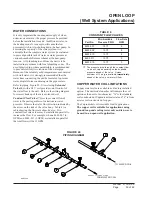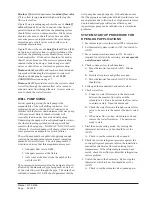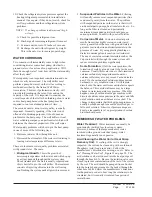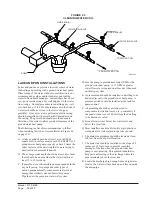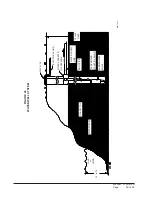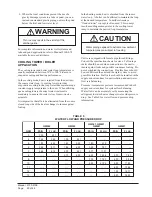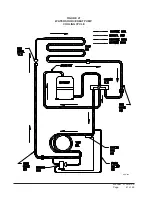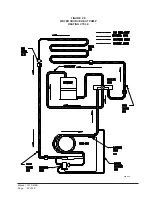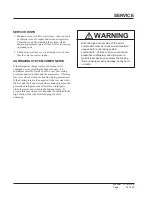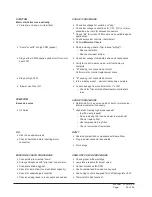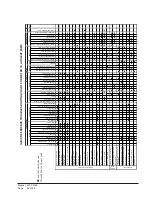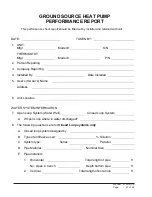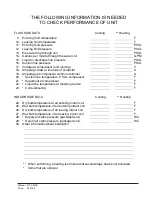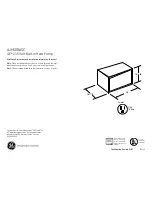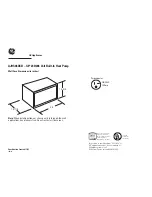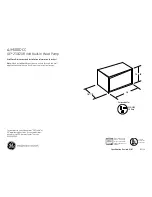
Manual 2100-419E
Page
37 of 48
10. Check the refrigerant system pressures against the
heating refrigerant pressure table in installation
manual. Once again, if they do not match, check for
air flow problems and then refrigeration system
problems.
NOTE: If a charge problem is determined (high
or low):
A. Check for possible refrigerant loss.
B. Discharge all remaining refrigerant from unit.
C. Evacuate unit down to 29 inches of vacuum.
D. Recharge the unit with refrigerant by weight.
This is the only way to insure proper charge.
WATER CORROSION
Two concerns will immediately come to light when
considering a water source heat pump, whether for
ground water or for a closed loop application: Will
there be enough water? And, how will the water quality
affect the system?
Water quantity is an important consideration and one
which is easily determined. The well driller must
perform a pump down test on the well according to
methods described by the Nation Well Water
Association. This test, if performed correctly, will
provide information on the rate of low and on the
capacity of the well. It is important to consider the
overall capacity of the well when thinking about a water
source heat pump because the heat pump may be
required to run for extended periods of time.
The second concern, about water quality, is equally
important. Generally speaking, if the water is not
offensive for drinking purposes, it should pose no
problem for the heat pump. The well driller or local
water softening company can perform tests which will
determine the chemical properties of the well water.
Water quality problems will show up in the heat pump
in one of more of the following ways:
1. Decrease in water flow through the unit.
2. Decreased heat transfer of the water coil (entering to
leaving water temperature difference is less).
There are four main water quality problems associated
with ground water. These are:
1.
Biological Growth
.
This is the growth of
microscopic organisms in the water and will shop up
as a slimy deposit throughout the water system.
Shock treatment of the well is usually required and
this is best left up to the well driller. The treatment
consists of injecting chlorine into the well casing
and flushing the system until all growth is removed.
2.
Suspended Particles in the Water
.
Filtering
will usually remove most suspended particles (fine
sand, small gravel) from the water. The problem
with suspended particles in the water is that it will
erode metal parts, pumps, heat transfer coils, etc. So
long as the filter is cleaned and periodically
maintained, suspended particles should pose no
serious problem. Consult with your well driller.
3.
Corrosion of Metal
.
Corrosion of metal parts
results from either highly corrosive water (acid
water, generally not the case with ground water) of
galvanic reaction between dissimilar metals in the
presence of water. By using plastic plumbing or
dielectric unions galvanic reaction is eliminated.
The use of corrosion resistant materials such as the
Cupro nickel coil) through the water system will
reduce corrosion problems significantly.
4.
Scale Formation
.
Of all the water problems, the
formation of scale by ground water is by far the most
common. Usually this scale is due to the formation of
calcium carbonate by magnesium carbonate or
calcium sulfate may also be present. Carbon dioxide
gas (CO
2
), the carbonate of calcium and magnesium
carbonate, is very soluble in water. It will remain
dissolved in the water until some outside factor upsets
the balance. This outside influence may be a large
change in water temperature or pressure. When this
happens, enough carbon dioxide gas combines with
dissolved calcium or magnesium in the water and falls
out of solution until a new balance is reached. The
change in temperature that this heat pump produces is
usually not high enough to cause the dissolved gas to
fall out of solution. Likewise, if pressure drops are
kept to a reasonable level, no precipitation of carbon
dioxide should occur.
REMEDIES OF WATER PROBLEMS
Water Treatment.
Water treatment can usually be
economically justified for close loop systems.
However, because of the large amounts of water
involved with a ground water heat pump, water
treatment is generally too expensive.
Acid Cleaning the Water Coil or Heat Pump
Recovery Unit.
If scaling of the coil is strongly
suspected, the coil can be cleaned up with a solution of
Phosphoric Acid (food grade acid). Follow the
manufacturer’s directions for mixing, use, etc. Refer to
the “Cleaning Water Coil”, Figure 25 on page 38. The
acid solution can be introduced into the heat pump coil
through the hose bib A. Be sure the isolation valves are
closed to prevent contamination of the rest of the system
by the coil. The acid should be pumped from a bucket
into the hose bib and returned to the bucket through the
other hose bib B. Follow the manufacturer’s directions
for the product used as to how long the solutionis to be
circulated, but it is usually circulated for a period of
several hours.
Содержание QW242
Страница 6: ...Manual 2100 419E Page 6 of 48 FIGURE 1 UNIT DIMENSIONS ...
Страница 9: ...Manual 2100 419E Page 9 of 48 FIGURE 4 INSTALLATION OF UNIT THROUGH WALL WITH WALL SLEEVE MIS 1564 ...
Страница 21: ...Manual 2100 419E Page 21 of 48 FIGURE 15 REMOTE THERMOSTAT WIRING DIAGRAM X OPTION ...
Страница 22: ...Manual 2100 419E Page 22 of 48 FIGURE 16 REMOTE THERMOSTAT WIRING DIAGRAM A THERMOSTAT OPTION 4102 021A ...
Страница 23: ...Manual 2100 419E Page 23 of 48 4102 022C FIGURE 17 REMOTE THERMOSTAT WIRING DIAGRAM D THERMOSTAT OPTION ...
Страница 41: ...Manual 2100 419E Page 41 of 48 FIGURE 27 WATER SOURCE HEAT PUMP COOLING CYCLE MIS 329 ...
Страница 42: ...Manual 2100 419E Page 42 of 48 FIGURE 28 WATER SOURCE HEAT PUMP HEATING CYCLE MIS 328 ...













